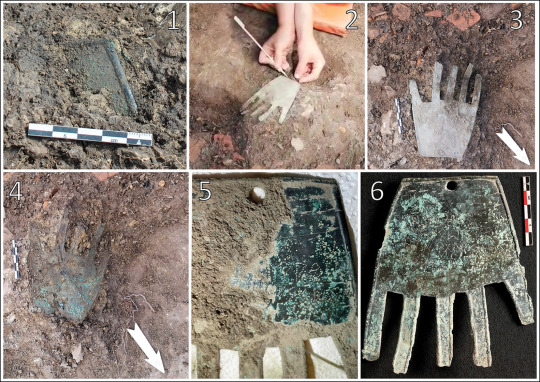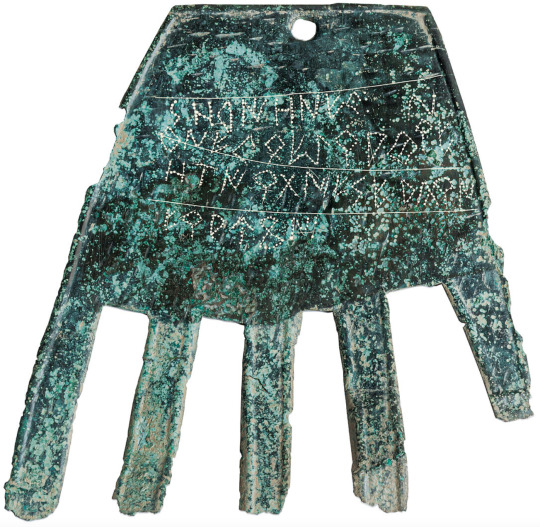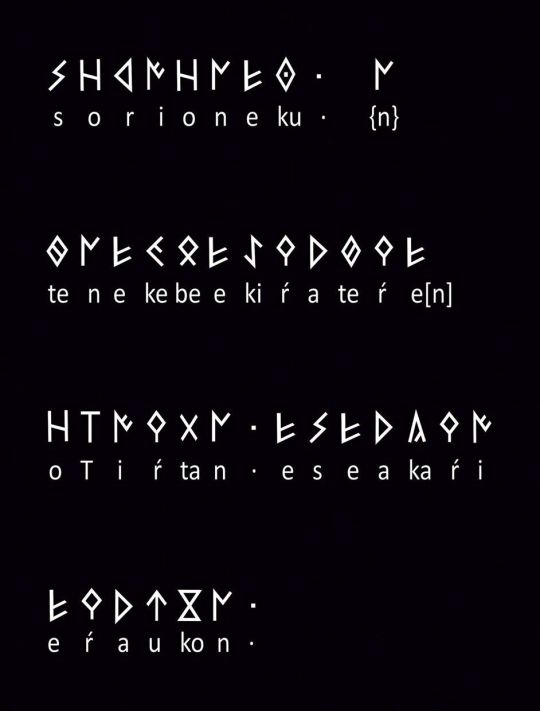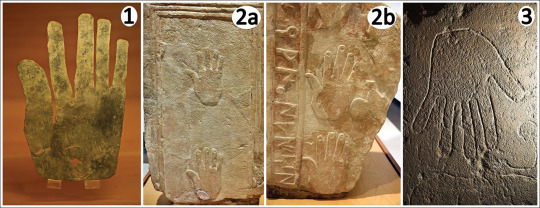#Hand of irulegi
Text
Some new conclusions regarding the Hand of Irulegi

The stippled text can be read as follows:
sorioneku ⋅
kunekebeekiŕateŕe/ /n
oTiŕtan ⋅ eseakaŕi
eŕaukon ⋅
The script used for the text on the Irulegi hand clearly belongs to the family of the Palaeohispanic semi-syllabaries. 18 different signs can be discerned. The presence of the T sign in a non-numismatic text is highly significant, because it demonstrates that this sign was used in multiple epigraphic contexts and because it confirms the existence of a graphic subsystem that, considering its geographical distribution and the increasingly solid linguistic evidence associated with it, must be described as a ‘Vasconic script’. Where and how such an adaptation occurred are aspects about which we currently know very little.
None of the words identified can be directly related to Vasconic or Iberian anthroponyms. The remarkable similarity between the first word in the text, sorioneku, and the Basque word zorioneko—‘of good fortune’, a flection-derivation of the sequence zori ‘fortune’ + (h)on ‘good’—could be taken to be a coincidence, were it not for the evident symbolism of the artefact and its findspot at the heart of Vasconic territory. Both words are of early date within the Basque vocabulary; even the union of both elements is recorded in the oldest Basque documents (e.g. zorionean ‘fortunately’ used by both Joan Perez Lazarraga and Bernat Dechepare in the 16th century).
The sgraffito version, however, offers sorioneke. The reason for this difference is obscure; the final -(e)ke may be the ending of some Basque-Aquitaine divinities recorded in Latin inscriptions on altars, such as the theonyms Larrahe and Herauscorritsehe. This word could mention the divinity, be it Good Fortune or another deity, to which the inscription would have been dedicated.
In line 3 it is possible to isolate oTiŕtan. This could be interpreted as a toponym given the possible presence of a formative suffix ta [da] in its lexical structure, (which is identical to that of the well-known toponym iltiŕta = Ilerda) as well as the Vasconic locative -n desinence. Depending on the value given, it would be the toponym Osserda or Ol(l)erda in its Latin transcription.
Among the rest of the words identified, eŕaukon is the most likely to be a verbal form, both because of its form and its final position. Its form recalls the Basque form of the past tense of the auxiliary verb zeraukon, used in eastern dialects; it is a form of *eradun—causative of *edun—‘to make have’ > ‘to give’, marginally used as an autonomous verb still in the sixteenth century, prior to its use as an auxiliary. The meaning of this verb would make sense in the case of a votive dedication, although several aspects are debatable.

The rest of the inscription on the Irulegi hand remains quite obscure. While here are problems in relation to the Basque words adduced as parallels, the inscription can be interpreted as a dedication to a divinity named at the beginning (sorioneke /-ku), with a dedication verb at the end (eŕaukon) whose object would go immediately before (ese-agaŕi). A place (oTiŕtan) may likewise be indicated, leaving the expression of the individual making the dedication and some other specification in the obscure line 2.
The inscription provides support for a growing awareness that the ancient Vascones knew and made use of writing, at least to a degree.
The use of sorioneku or sorioneke at the beginning of the text, isolated from what follows as an introduction admits comparison with Basque zori (h)on (‘good fortune’), and other elements, such as the verbal form eŕaukon or the locative in -n of a place-name, suggest that the inscription is in the Vasconic language, the longest and earliest known to date.
The implications of the discovery of the Irulegi hand for the epigraphic and historical understanding of the Vasconic territory, as well as the possible linguistic connections between the Vasconic, Iberian and modern Basque languages, require further in-depth analysis. Given the scarcity of other firm evidence, the Irulegi hand and its inscription will henceforth constitute an indispensable starting point for the establishment of a linguistic map of the region and any debate on the origin and development of the Vasconic language and script.
Full article
Eskerrik asko @glendathegoodone for sharing this!
#euskal herria#pays basque#basque country#pais vasco#euskadi#culture#hand of irulegi#irulegiko eskua#irulegi#nafarroa#history#linguistics#archaeology#news#vascones
89 notes
·
View notes
Photo

Aranzadi zientzia elkarteak aurkituriko Irulegiko eskuari buruzko libururako infografiak.
Illustrations for the book about the Irulegi hand discovered by Aranzadi science society.
#infografia#ilustrazioa#Aranzadi#Irulegi#Irulegiko eskua#Sorioneku#Aranzadi zientzia elkartea#marrazkia#marrazkiak#Ilustrazioak#Illustration#illustrations#Digital Illustration#drawing#drawings#art#irulegi hand#artists on tumblr
0 notes
Text
"Bucky! Bucky, your arm's great-great-great-grandpa is in the news!"
Bucky groans and buries his face in the crack between his pillow and Clint's. He has no idea what the fuck his boyfriend is talking about, but he's pretty sure no good will come of asking questions.
"The two-thousand-year-old bronze hand is the first evidence that these Iron Age settlers used written language," Clint reads. "The previous earliest written documentation of the Basque language dates from the 9th or 10th century AD. It's called the Hand of Irulegi, that's so badass!"
Bucky reluctantly rolls onto his side, blinking blearily at Clint's phone screen. There's a picture of a greenish piece of metal that looks kind of like a blocky hand, a little. "That's not my arm's great-great-great-grandpa," he says, his voice croaky. "Two thousand years is a lot more generations than that."
Clint waves a hand dismissively. "Metal lives longer, shush, I decided it makes sense. Hey, it says the hand may have hung from the door of a dwelling to provide protection. Keeping the fam safe, just like you!"
Bucky shifts up onto his elbow to look closer at the screen. "Researchers found evidence that the area had suffered a fire caused by an attack in which Roman arrowheads were used. Guess my arm's ancestor was no match for your bow's ancestors."
"Aw, protohistoric family feuds, no." Clint scrolls down the page. "The first word on the hand reads sorioneku, translating to of good fortune. Lucky, you're the earliest known example of written Basque!"
Lucky hears his name and clambers up the bed, stepping directly on Bucky's stomach. Bucky grunts and collapses back onto the pillow, letting the dog wriggle between them. He knows by now that if he fights it he'll just get sad puppy eyes from both of them.
Clint drops his phone and tosses an arm across Lucky, resting his hand on top of Bucky's metal one. "I'm glad your hand is here to protect my dwelling," he mumbles, already sounding halfway back to asleep.
Sorioneku, Bucky thinks, squeezing Clint's hand fondly. Maybe he'll see if he can get that etched into the vibranium.

#winterhawk#ficlet#clint barton#bucky barnes#history#this was just announced yesterday and it's super fucking cool#lbr there is a nonzero chance bucky might have to protect the dwelling from clint's fire arrows
80 notes
·
View notes
Text
wake up babe we mightve just found the earliest historic basque text [14 Nov 22]
71 notes
·
View notes
Text
8 notes
·
View notes
Link
The Hand of Irulegi is an unprecedented example of pre-Roman Vasconic writing. The language in this script may be related to Aquitanian, found in names across southern Gaul and an ancestor of today’s Basque language. Click the link to learn more!
2 notes
·
View notes
Text
Really fascinating. Basque is an extremely difficult language to learn. It has also been called the oldest surviving language, although I'm skeptical about that.
5 notes
·
View notes
Text
I am also halfway down a rabbit hole about this castellano professor's 12-year study (unrelated to prev post about the Hand of Irulegi) and his conclusion that Euskera is related to the Malian language Dogon, why Euskadi authorities rejected it, and why this debate didn't seem to make it to the English language press at all, but that's something to look into another time
#language#euskera#spain#i mean since euskera is one of linguistics'/philology's great white whale mysteries#i'm guessing if the story didn't cross over it's because the study is fucked somehow#IT'S NOT LIKE THERE WOULDN'T BE INTEREST#gonna have to take to google scholar for this one.
2 notes
·
View notes
Text
Hand of Irulegi: ancient artefact could help trace origins of Basque language
https://www.theguardian.com/world/2022/nov/15/hand-of-irulegi-ancient-spanish-artefact-rewrites-history-of-basque-language
Comments
1 note
·
View note
Text
A late Iron Age cultural group that occupied the western Pyrenees, in the approximate area of present-day Navarre.
Still very little is understood about the language, writing, identity and beliefs of these pre-Roman Vasconic communities but the clue given by the Irulegi Hand may help us learn more about this culture.
0 notes
Text

The oldest words written in proto-Basque.
They appeared on the Hand of Irulegi, a metal piece that was found in 2021 and dates back to around 80BCE.
They're still being studied to achieve a translation, but the first one - sorioneku - had a great impact in every Basque speaker due to its stounding resemblance to modern Basque zorioneko: lucky, for good luck. It has already become a Basque symbol and you'll find it in many souvenirs.
It's not crazy to think that the word meant the same 2,000 years ago since the hand was a presumed lucky charm that used to be hung over the door of a house; so maybe the inscription starts something like "lucky be the ones of this house". We'll have to wait for a proper translation, though!
#euskal herria#basque country#pays basque#pais vasco#euskadi#nafarroa#irulegiko eskua#hand of irulegi#proto basque#euskararen nazioarteko eguna#international day of basque language
96 notes
·
View notes
Photo

Hand of Irulegi: ancient bronze artefact could help trace origins of Basque language | Spain | The Guardian
The Vascones, an iron age tribe from whose language modern Basque is thought to descend, previously viewed as largely illiterate
5 notes
·
View notes
Text
hand of Irulegi: an ancient Spanish artifact rewrites the history of the Basque language | Spain
hand of Irulegi: an ancient Spanish artifact rewrites the history of the Basque language | Spain
More than 2,000 years after it was likely hung on the door of a mud-brick house in northern Spain for good luck, a flat, life-size bronze hand engraved with dozens of eerie symbols could help researchers trace the development of one of the most mysterious in the world. languages.
Although the piece – known as the Hand of Irulegi – was discovered last year by archaeologists from the Scientific…
View On WordPress
0 notes
Note
In regards to the Hand of Irulegi, I noticed that it's unanimous that the hand is considered to be a Right Hand due to the Right Hand's association with good fortune and bestowing things and the main word we have is sorioneku.
However, given the way it is hung at the wrist area, it looks like it would be a left hand. If it was a right hand then the inscription would be on the back of the palm, which seems strange when it is evoking a god or bestowing a blessing. But if we take the inscription as being on the inside of the palm, the orientation would make it a left hand.
Is there reason beyond the ubiquitousness of Right Hand = Good to believe it is a right hand?
Kaixo anon!
Some of your questions are explained in the full article mentioned as the source.
Seemingly, it was an Iberian and Vasconic custom to cut off the hands or heads of the enemies to display them at home or near some roads as a warning. And this is one of the reasons experts think hands - especially right hands - were an important symbol for these cultures.
There are several examples that have been found, all of them right hands:

Also, and weird as it may be, the inscriptions found on these hands are on the back and not on the palm, so the hand of Irulegi just follows this tradition:

As to why right hand = good, we can only speculate. Probably because most people are right-handed and it was regarded as the hand necessary to do almost everything: most importantly, wield a weapon, but also to create art for the deities, feed the babies, cut the wheat, etc.
#euskal herria#basque country#pays basque#pais vasco#euskadi#culture#history#hand of irulegi#hands#irulegijo eskua#archaeology#iberian people#vascon people#anons
12 notes
·
View notes
Text

The hand of Irulegi, spotted at the Tour de France.
Source
#euskal herria#basque country#pays basque#pais vasco#euskadi#tour de france#tour 2023#cycling#Hand of Irulegi#awesome#photography#nature
38 notes
·
View notes